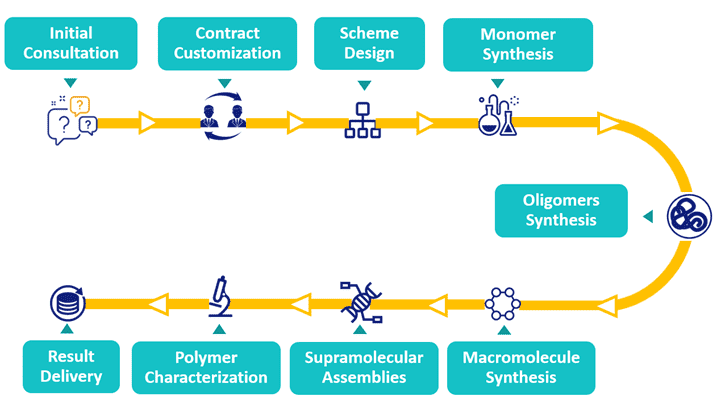Protein-polymer bioconjugates have shown great promises in biomedical and life science applications, including drug delivery and diagnosis. As a leading supplier of monomers and polymers, BOC Sciences specializes in the production of protein-polymer conjugates via atom transfer radical polymerization (ATRP) and reversible addition-fragmentation chain transfer (RAFT) polymerization to meet your research and production needs. Our experienced R&D scientists support protein functionalization of side chains and end-group of cysteine (Cys), lysine (Lys), tyrosine (Tyr), glutamine (Gln), and unnatural amino acid.

Proteins are the major machinery of most biological processes, including structure formation, catalysis, and transport, and these unique features are based on their defined monomer sequences and precise 3D structures. Protein-polymer conjugates are important materials in biotechnology, nanotechnology, and medicine. The specificity of proteins makes them inherently well suited in diverse fields, while synthetic polymers further enhance application values. Protein-polymer conjugates display improved properties, such as increased stability and solubility, compared to native proteins.
 Fig. 1. Routes for protein-polymer conjugates synthesis.
Fig. 1. Routes for protein-polymer conjugates synthesis.
Protein-polymer conjugates are hybrid biomacromolecules designed to display a wide diversity of functional and structural characteristics of both their synthetic and biological components. Certain native proteins exhibit reduced stability under non-physiological conditions, are susceptible to enzymatic degradation, trigger undesirable immune responses, cannot penetrate most biological barriers, and are below the kidney filtration threshold. Protein-polymer conjugates have mostly evolved to overcome such limitations and improved stability, solubility, biodistribution, circulation half-life, and decreased antigenicity of such proteins. In addition, the unlimited chemical diversity of polymers offers the possibility to convey enhanced properties to natural biomacromolecules. Ever since the first generation of PEGylated proteins several decades ago, hydrophilic protein-polymer bioconjugates of remarkable complexity and diverse functionality have evolved.

Side-chain Protein-polymers Preparation
Various (controlled) radical polymerization methodologies may prepare side-chain functional polymers. Within this approach, monomers bearing side-groups that are susceptible to chemoselective reactions are polymerized either in the protected or unprotected form and then reacted with an appropriately functional protein. BOC Sciences can provide comprehensive custom synthesis services of side-chain functional polymers involving monomers bearing side-group active esters, protected or free ketones and aldehydes, protected maleimides, protected alkynes, azides, and p-aryl halides.
End-group Protein-polymers Preparation
End-group protein-reactive polymers can be prepared using various controlled or living polymerization techniques and appropriate functional initiators. These initiators are designed to be inert with respect to the polymerization reaction in their native or protected form, which may be activated following polymerization. Alternatively, a functional terminator may terminate the polymerization process, thereby conferring functionality to the end of polymers. BOC Sciences can prepare end-group protein-polymers, such as α-functionalized polymers and ω-functionalized polymers, using appropriate functional initiators. Our technical team has years of experience in polymer bioconjugation that ensure product accuracy.
 Fig. 2. Common protein handles and reactive groups for covalent polymer bioconjugates (Advanced Drug Delivery Reviews. 2021, 174: 447-460).
Fig. 2. Common protein handles and reactive groups for covalent polymer bioconjugates (Advanced Drug Delivery Reviews. 2021, 174: 447-460).
Protein-templated Synthesis of Polymers
Polypeptide-PEG conjugates based on denatured proteins can be used in various biomedical applications or as precision substrates for well-defined nanomaterial synthesis. This approach has been widely applied to prepare linear polymers with determined chain lengths and functional groups at defined locations along the chain by acylation of denatured proteins. Currently, denatured protein-PEG conjugates are widely used in the industry. BOC Sciences can design PEG chains of various molecular weights (2000-5000 Da) to conjugate denatured protein via a covalent bond, such as either thiol-maleimide or amine-NHS ester. Furthermore, We also provide customized services for protein cage-based polymer conjugation.
Assemblies of Protein-polymer Conjugates
In recent years, self-assembled nanoparticles based on protein-polymer conjugates have been intensively explored as carriers for delivering anticancer drugs. Due to the presence of proteins, these self-assembled nanostructures possess special built-in bioactivities. BOC Sciences has the ability to self-assemble protein-polymer conjugates into fibers, vesicles, and rings via atom transfer radical polymerization (ATRP) and reversible addition-fragmentation chain transfer (RAFT). We monitor products in accordance with strict quality control standards throughout development and coupling to ensure top-notch services and products for our customers.
Surface-deposited Protein-polymer Conjugates
Due to their robustness, versatility, and good processability, synthetic polymers have been used extensively with immobilized biomolecules, including peptides and enzymes on various surfaces, and revealed potential applications in biosensors, biotechnology, and biomedical devices. BOC Sciences can construct functional surfaces with attractive biological activities, such as antibacterial and cell adhesion properties, by either direct deposition of polymer bioconjugates or stepwise immobilization of polymers and biomolecules on surfaces.

References